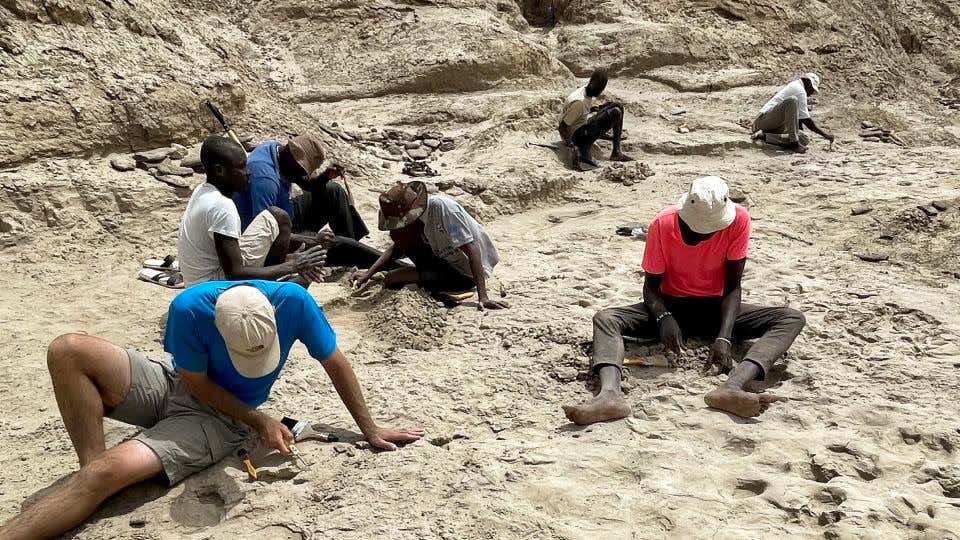1.5 million-year-old footprints from two different co-existing human species found in Kenya
Fossilized footprints in Kenya reveal Homo erectus and Paranthropus boisei coexisted 1.5M years ago, offering insights into human evolution.

Members of the research team excavated the trackway surface in 2022. (CREDIT: Neil T. Roach/Harvard University)
For millions of years, eastern Africa was a crucible of human evolution, hosting a complex interplay of species. Fossilized footprints discovered near Lake Turkana in Kenya have provided an unprecedented glimpse into the interactions between two ancient hominins:
Homo erectus and Paranthropus boisei. These footprints, preserved in soft mud for 1.5 million years, tell a story of coexistence, competition, and survival.
Recent research published in Science examined these footprints and identified distinct walking patterns for the two species, offering hard evidence of their simultaneous presence in the same environment.
The footprints, discovered in the Koobi Fora Formation, represent more than mere tracks. They capture a moment in time when these two species crossed paths, possibly within hours of each other.
Kevin Hatala, the lead author and a biologist at Chatham University, highlighted the significance of fossilized footprints. “They provide vivid snapshots that bring our fossil relatives to life,” he said. Unlike bones or tools, footprints record the behavior of living individuals, offering a direct link to the past.
A Shared Habitat
Both species appeared to favor the lake margin’s muddy shore. This area likely offered rich resources but also posed significant dangers, with predators like crocodiles and hippos lurking nearby.
Geological analysis by Craig Feibel, a co-author and stratigraphy expert at Rutgers University, confirmed the footprints’ age and depositional environment. Feibel described the scene as “a delta system with shallow, low-energy water and perfect mud for preserving tracks.”
Related Stories
The footprints were pristinely preserved under layers of fine sediment. This natural process sealed them shortly after formation, preventing exposure to air or erosion. The lack of surface cracking indicates the tracks were made within a narrow timeframe, potentially hours or days apart.
Feibel emphasized the rarity of this find. “This proves beyond any question that two different hominins walked on the same surface, almost at the same time,” he said. While fossil records have long suggested coexistence, this is the first direct evidence that these species inhabited the same space in such close temporal proximity.
Diverging Adaptations
The study revealed key differences in the anatomy and movement of the two species. Hatala and his team used cutting-edge 3D imaging to analyze the footprints. They compared them with tracks made by modern humans, the Daasanach people of Ethiopia, and even chimpanzees.
The long trackway of 12 consecutive footprints was attributed to Paranthropus boisei, a species known for its robust build, massive jaws, and plant-based diet. The shorter, isolated tracks, more human-like in nature, were linked to Homo erectus, a species characterized by its omnivorous diet and advanced bipedal locomotion.
“From the neck down, Homo erectus resembled modern humans,” Hatala explained. This similarity, coupled with their footprints’ gait and motion, strengthens the hypothesis that Homo erectus was a direct ancestor of modern humans.
In contrast, P. boisei possessed adaptations for a very different evolutionary path, including powerful chewing muscles and a reliance on plant matter.
A Long-Standing Relationship
Skeletal evidence from the region suggests that H. erectus thrived for over a million years, while P. boisei disappeared a few hundred thousand years after these footprints were made. Despite their differences, the two species coexisted in the same region for at least 100,000 years.
Hatala noted that their prolonged overlap implies a level of mutual tolerance or minimal competition. “They must have been okay with one another living on the same landscape,” he said. However, what interactions they had—whether cooperative, competitive, or neutral—remain speculative.
Briana Pobiner, a research scientist at the Smithsonian National Museum of Natural History, described the finding as “mind-blowing.” She remarked, “This tells us that they lived in the same place, at the same time, and walked practically next to each other.”
Trace fossils, such as footprints, differ from body fossils like bones and teeth. They are immovable and provide behavioral evidence. This makes them invaluable for understanding ancient ecosystems. Feibel described the footprints as “serendipitous,” discovered by a team led by Louise Leakey in 2021 during routine excavations.
The excavation, completed in 2022, uncovered 23 square meters of sediment containing 14 hominin footprints. These were accompanied by tracks of large birds and hoofed animals, painting a vivid picture of the ecosystem. One bird track, likely from a giant stork, measured an impressive 27 centimeters across.
Implications for Human Evolution
The discovery has sparked speculation about how these species interacted. Did they compete for food or coexist peacefully? Did they mate and exchange genetic material, as modern humans did with Neanderthals and Denisovans?
Pobiner suggested the possibility of interbreeding. “Maybe they even mated with each other on occasion,” she said. While there is no direct evidence of such interactions, the physical proximity of the footprints raises intriguing questions.
Hatala added that the lake margins likely held a strong appeal for both species despite the risks. The environment offered resources crucial for survival, including water and vegetation. Their repeated use of the area over millennia underscores its importance.
This discovery bridges a gap in the fossil record, offering a tangible connection to a moment in prehistory. It provides a deeper understanding of the evolutionary dynamics that shaped the human lineage.
Hatala summarized the excitement of the find: “It’s impossible to go back in time to observe these species, but having their footprints together on the same surface? That’s the next best thing.”
The coexistence of Homo erectus and Paranthropus boisei challenges assumptions about early human evolution. It highlights the complexity of hominin interactions and underscores the importance of fossilized footprints as a tool for unraveling our shared past.
Key facts about Homo Erectus
First to Use Fire and Cook Food
Homo erectus is believed to have been the first hominin to harness fire, a transformative step in human evolution. This ability allowed them to cook food, making it easier to digest and providing more nutrients, which may have supported brain growth.
Longest-Living Hominin Species
Homo erectus existed for nearly 1.9 million years, from around 2 million to 100,000 years ago, making them one of the longest-surviving hominin species. They spanned multiple continents, including Africa, Asia, and parts of Europe.
Advanced Tool Use
They were skilled toolmakers, associated with the Acheulean tool culture. This involved creating handaxes and other bifacial tools, showcasing improved craftsmanship compared to earlier hominins.
Larger Brain and Body Size
Homo erectus had a larger brain volume than earlier species, averaging around 900 cubic centimeters. They also exhibited a body size and proportions closer to modern humans, with height estimates ranging from 4.9 to 6.1 feet.
First Hominin to Migrate Out of Africa
They were the first hominin species to leave Africa and adapt to diverse environments, reaching areas such as Java (Indonesia) and China. This migration highlights their ability to adapt and innovate in various ecological conditions.
Key facts about Paranthropus boisei
- Distinctive Physical Traits
Paranthropus boisei had a robust skull with striking features, including large cheekbones, a prominent sagittal crest (a ridge of bone on top of the skull for anchoring powerful jaw muscles), and massive molars. These traits were adaptations for processing tough, fibrous plant material. - Nicknamed "Nutcracker Man"
Discovered by Mary Leakey in 1959 at Olduvai Gorge in Tanzania, the species earned its nickname due to its massive teeth and powerful jaws. However, later studies suggest its diet may have included softer, more varied foods like fruits and roots. - Lived About 2.3–1.2 Million Years Ago
Paranthropus boisei roamed East Africa during the Pleistocene epoch, with fossil evidence found in Tanzania, Kenya, and Ethiopia. It coexisted with other hominin species, including early members of the genus Homo. - Dietary Specialization
Analysis of tooth enamel and wear patterns reveals that P. boisei primarily consumed low-quality plant materials such as grasses and sedges. Isotopic studies suggest their diet was uniquely high in C4 plants compared to other contemporary hominins. - Evolutionary Dead End
Despite its robust build and specialized adaptations, Paranthropus boisei is considered an evolutionary offshoot that did not lead to modern humans. Instead, its lineage went extinct while more gracile hominins, like Homo erectus, thrived and evolved further.
These traits make P. boisei a fascinating example of evolutionary diversity among early hominins.
Note: Materials provided above by The Brighter Side of News. Content may be edited for style and length.
Like these kind of feel good stories? Get The Brighter Side of News' newsletter.
Joshua Shavit
Science & Technology Writer | AI and Robotics Reporter
Joshua Shavit is a Los Angeles-based science and technology writer with a passion for exploring the breakthroughs shaping the future. As a contributor to The Brighter Side of News, he focuses on positive and transformative advancements in AI, technology, physics, engineering, robotics and space science. Joshua is currently working towards a Bachelor of Science in Business Administration at the University of California, Berkeley. He combines his academic background with a talent for storytelling, making complex scientific discoveries engaging and accessible. His work highlights the innovators behind the ideas, bringing readers closer to the people driving progress.



